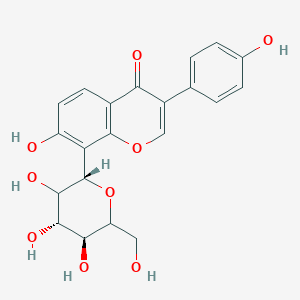| MeSH term | MeSH ID | Detail |
|---|---|---|
| Liver Cirrhosis | D008103 | 67 associated lipids |
| Memory Disorders | D008569 | 33 associated lipids |
| Parkinson Disease | D010300 | 53 associated lipids |
| Urinary Incontinence | D014549 | 4 associated lipids |
| Reperfusion Injury | D015427 | 65 associated lipids |
| Glucose Intolerance | D018149 | 13 associated lipids |
| Alcohol-Related Disorders | D019973 | 3 associated lipids |
| Infarction, Middle Cerebral Artery | D020244 | 35 associated lipids |
| Ventricular Remodeling | D020257 | 28 associated lipids |
| Neurotoxicity Syndromes | D020258 | 34 associated lipids |
SCHEMBL105486
Kakonein is a lipid of Polyketides (PK) class. Kakonein is associated with abnormalities such as Fatty Liver, Chronic liver disease, Morphologically altered structure, Hypertensive disease and Cardiovascular Diseases. The involved functions are known as protein expression, Extravasation, Liver damage, mRNA Expression and cell activation. Kakonein often locates in Body tissue, Hepatic, Microvilli, Cytoplasm and Membrane. The associated genes with Kakonein are TJP1 gene, CD14 gene, iberiotoxin, AT-Rich Interactive Domain-Containing Protein 1A and NKS1 gene. The related lipids are dehydrosoyasaponin I and Steroids. The related experimental models are Knock-out.
Cross Reference
Introduction
To understand associated biological information of SCHEMBL105486, we collected biological information of abnormalities, associated pathways, cellular/molecular locations, biological functions, related genes/proteins, lipids and common seen animal/experimental models with organized paragraphs from literatures.
What diseases are associated with SCHEMBL105486?
SCHEMBL105486 is suspected in Chronic liver disease, Hypertensive disease, Cardiovascular Diseases, Myocardial Infarction, Cerebrovascular accident, Fatty Liver and other diseases in descending order of the highest number of associated sentences.
Related references are mostly published in these journals:
| Disease | Cross reference | Weighted score | Related literature |
|---|
Possible diseases from mapped MeSH terms on references
We collected disease MeSH terms mapped to the references associated with SCHEMBL105486
PubChem Associated disorders and diseases
What pathways are associated with SCHEMBL105486
There are no associated biomedical information in the current reference collection.
PubChem Biomolecular Interactions and Pathways
Link to PubChem Biomolecular Interactions and PathwaysWhat cellular locations are associated with SCHEMBL105486?
Visualization in cellular structure
Associated locations are in red color. Not associated locations are in black.
Related references are published most in these journals:
| Location | Cross reference | Weighted score | Related literatures |
|---|
What functions are associated with SCHEMBL105486?
Related references are published most in these journals:
| Function | Cross reference | Weighted score | Related literatures |
|---|
What lipids are associated with SCHEMBL105486?
Related references are published most in these journals:
| Lipid concept | Cross reference | Weighted score | Related literatures |
|---|
What genes are associated with SCHEMBL105486?
Related references are published most in these journals:
| Gene | Cross reference | Weighted score | Related literatures |
|---|
What common seen animal models are associated with SCHEMBL105486?
Knock-out
Knock-out are used in the study 'MATE2 mediates vacuolar sequestration of flavonoid glycosides and glycoside malonates in Medicago truncatula.' (Zhao J et al., 2011).
Related references are published most in these journals:
| Model | Cross reference | Weighted score | Related literatures |
|---|
NCBI Entrez Crosslinks
All references with SCHEMBL105486
Download all related citations| Authors | Title | Published | Journal | PubMed Link |
|---|---|---|---|---|
| Gao Y et al. | An isoflavonoid-enriched extract from Pueraria lobata (kudzu) root protects human umbilical vein endothelial cells against oxidative stress induced apoptosis. | 2016 | J Ethnopharmacol | pmid:27717903 |
| Song XB et al. | Puerarin protects against cadmium-induced proximal tubular cell apoptosis by restoring mitochondrial function. | 2016 | Chem. Biol. Interact. | pmid:27717697 |
| Liu H et al. | Coadministration of puerarin (low dose) and zinc attenuates bone loss and suppresses bone marrow adiposity in ovariectomized rats. | 2016 | Life Sci. | pmid:27697446 |
| Wang C et al. | Protective effects of puerarin on acute lung and cerebrum injury induced by hypobaric hypoxia via the regulation of aquaporin (AQP) via NF-κB signaling pathway. | 2016 | Int. Immunopharmacol. | pmid:27643664 |
| Zhao L et al. | Protective Effects of Genistein and Puerarin against Chronic Alcohol-Induced Liver Injury in Mice via Antioxidant, Anti-inflammatory, and Anti-apoptotic Mechanisms. | 2016 | J. Agric. Food Chem. | pmid:27609057 |
| Ma Y et al. | Puerarin Attenuates Anoxia/Reoxygenation Injury Through Enhancing Bcl-2 Associated Athanogene 3 Expression, a Modulator of Apoptosis and Autophagy. | 2016 | Med. Sci. Monit. | pmid:27011313 |
| Luo X et al. | Puerarin Exerts a Delayed Inhibitory Effect on the Proliferation of Cardiomyocytes Derived from Murine ES Cells via Slowing Progression through G2/M Phase. | 2016 | Cell. Physiol. Biochem. | pmid:27008508 |
| Jiang QD and Li XP | Effect of puerarin on the expression of NMU, NPY, and POMC genes in the hypothalamus. | 2016 | Genet. Mol. Res. | pmid:26985919 |
| Su HF et al. | Absorptive interactions of concurrent oral administration of (+)-catechin and puerarin in rats and the underlying mechanisms. | 2016 | Acta Pharmacol. Sin. | pmid:26972494 |
| Xu X et al. | Puerarin reduces apoptosis in rat hippocampal neurons culturea in high glucose medium by modulating the p38 mitogen activated protein kinase and c-Jun N-terminal kinase signaling pathways. | 2016 | J Tradit Chin Med | pmid:26946623 |
